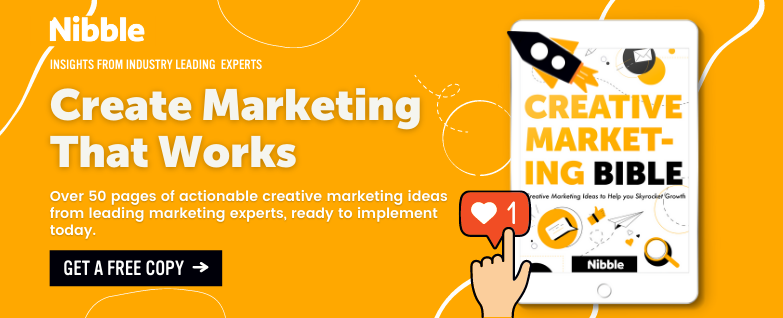Creative Business Storytelling: How to Create a Story That Sticks
Table of Contents
Introduction
Telling stories is human nature. We love a good yarn, and using storytelling as a way to communicate, teach and inspire action is a practice older than recorded history itself.
Putting such a fundamental, emotive technique into your brand comms can help your message stand out, get remembered and (crucially!) be acted on.
So stick with us to find out how to weave storytelling into your business’ strategy.
What is storytelling?
We should all know what storytelling is in essence – we’ve been hearing it since we were in the cot after all.
Basically, storytelling is using a narrative to communicate a message. There are characters, challenges to overcome and usually a satisfying resolution.
The aim of storytelling can vary widely. But generally, they’re great for teaching a lesson, entertaining an audience, or building affinity between speaker and listener.
Key elements of a good story
The key ingredients of a good story are:
- Characters
- Setting
- Challenge
- Resolution
For example, in the story of The Lord of the Rings, Frodo and the fellowship [characters] travel through middle earth [setting] to destroy the ring [challenge] and end Sauron’s threat to the world [resolution].
That’s the broad framework at least, but to make a story truly effective, you have to consider a few more elements:
- Entertaining: You have to keep your audience on the hook – engaged and interested in what’s coming next.
- Structured: Organise your story in a simple way to help convey your core message. Set the scene, introduce your characters and challenges, then when the stakes are apparent, the resolution will be more impactful.
- Relatable: The best stories are universal. They tap into recognisable emotions and experiences which increase the chances of them resonating with their audiences. This is vital for making them…
- Memorable: Make your story surprising, inspirational and emotive. These are all factors important for making you sticky.
How to apply the storytelling technique to your business?
Psychologist Jerome Bruner produced multiple publications on narrative, argument, learning and memory. In his book Actual Minds, Possible Worlds, he claims that information told within a story is approximately 22 times more likely to be remembered than facts alone.
That’s a huge increase, and one that businesses can’t afford to ignore when winning consumer attention and keeping it is so difficult.
Information told within a story is approximately 22 times more likely to be remembered than facts alone.
At this point, storytelling is already so widespread and effective in comms that you may not fully realise it’s even happening. On the other hand, some brands will wear their heart on their sleeve and make no attempt to hide the fact that they’re telling a story.
Using narrative and the elements above to make a connection between your brand and your customers can be done in a few ways.
Check out our blog post: How to create a viral video that converts?
Brand storytelling styles
1. Customer perspective e.g. Dropbox explainer video
Video explainers are the most common technique to boost sales you’ll see in marketing. A story from your customer’s point of view that aims to present a recognisable challenge, then position your brand as the solution.
Since the elements of a good story line up almost perfectly with the tried and tested formula of an animated explainer video, we feel uniquely qualified to lay out what we think makes a good story here!
2. Brand history and values e.g. TOMS shoes videos, about us pages, marketing
In a competitive marketing environment where humanity is at a premium, you can instead make your brand the focus. Tell the story, values or background of your business itself and the people that make it what it is.
A success here can move your customers even further down the commercial funnel. From a prospect to a customer, and from a customer to an evangelist.
Brands compete for mere seconds of their prospects’ attention with messaging that’s almost identical. Telling your unique story is one thing that your competitors can’t take away from you.
3. Prestige storytelling e.g. John Lewis Christmas ads
You could tell a story almost entirely separate from your product, service or brand. Some big brands want their primary focus to be communicating their values and spreading awareness with a form of business storytelling which is even closer to cinematic or novelistic forms.
It’s entertaining, memorable and emotive before anything else; an exercise to boost brand affinity and be as sticky as possible.
Business storytelling steps
1. Know your audience
No surprises here. As with any comms, you need to know who you’re going to be targeting.
2. Define a core message
What do you want your story to do? How are you going to make your primary message clear? This links back to the styles above. You might want to share your values, or frame your service as a problem-solver that your audience can’t live without.
3. Choose a call to action
What’s the profitable action that you’d like your story to inspire in your audience? This can be measurable like buying a product, subscribing to a mailing list, visiting a site or sharing a video. Don’t be shy, ask them to do it directly!
4. Choose a medium
Most business storytelling is happening in a handful of forms.
Visually: through video, animation or interactive media.
Written: in blogs or articles, or
Audio: like on a podcast or webinar, or by a speaker at an event.
For most businesses, a versatile video which can be shared in many different places will be the way to go here.
5. Produce it
Sounds simple, doesn’t it? Just put into practice everything you’ve just read! Or get an experienced creative studio or agency to help you out. Getting them involved even sooner than this step will be much more helpful if you decide to outsource production. They’ll be able to help you with your story from the very initial idea, and help to develop it from start to finish.
6. Publish and promote
Now just pick the channels available to you for your chosen story format and share away!
Pat yourself on the back, you’ve done it! Well… in theory anyway. Let’s take a look at some examples.
Business storytelling examples
Loterías y Apuestas del Estado – #Justino
This ad for the annual Spanish Christmas lottery has charm by the buckets, showing how effectively beautiful 3D animation paired with an emotive story can pull at your heart strings. Here, the storytelling is inspiring the sense of anticipation, potential and excitement you get from a lottery. This is emotive storytelling done right, the less said about similar attempts by banks the better…
You can see what one of their main aims is with the hashtagged title: they want social media attention. Well this ad was partnered with a strong social media push which was really successful. They even made a company page and employee accounts for the mannequin factory which actually inspired a huge amount of interaction!
Lyft – June: Life is Better When You Share the Ride
Lyft is Uber’s main competition and pretty big across the pond. In the ride sharing world, one of your messaging priorities is always going to be safety and community. That’s where lonely widow June comes in.
This ad is a stylish, engaging short film and a proper rollercoaster of emotion, telling the story of how June started using Lyft as a passenger and as a driver, effectively representing both sides of the company’s model.
Waitrose & John Lewis – Christmas 2020 Ad: Give A Little Love
People treat the annual John Lewis Christmas ads as a spectacle each year, like the next instalment of a cinematic series. There’s even a release date and plenty of anticipation here in the UK when they get launched.
You might look at that with a little cynicism, but one watch of their instalment from 2020 should melt that away. It’s a beautiful, simple story communicated with a whole range of animation styles to spread a message of love and community.
The products from John Lewis and Waitrose are indeed a motif throughout, but they’re not the main focus. The characters, their challenges and the resolutions to those challenges are.
This is a real masterclass in brand storytelling from a customer’s perspective, and one of our favourites not least because it shows off so many 2D, 3D, traditional and stop-motion animation styles!
Conclusion
You can see why storytelling is considered such a powerful tool for brands of all sizes – from household names and tech startups to small B2B solutions providers.
For businesses operating in a competitive space, a slick animated story can really cut through the noise. Especially for newer brands looking for an angle to set themselves apart from their established competition.
And bigger, older businesses can really effectively leverage their heritage, legacy and experience. Their stories humanise their brands and expose another, more emotive side to their customers.
The good news is that it isn’t hard to get started telling your brand’s story; Nibble has been doing it for years. So if you’d like to find out how we can work together to bring your story to life, just get in touch for a no-commitment chat.




